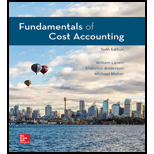
Fundamentals of Cost Accounting
6th Edition
ISBN: 9781260708783
Author: LANEN, William
Publisher: MCGRAW-HILL HIGHER EDUCATION
expand_more
expand_more
format_list_bulleted
Concept explainers
Textbook Question
Chapter 7, Problem 2RQ
Direct labor-hours and direct labor dollars are the most common allocation bases used in the United States (indeed, throughout the world). Why do you suppose they are used more than others?
Expert Solution & Answer
Want to see the full answer?
Check out a sample textbook solution
Students have asked these similar questions
MCQ
need this general accounting subject solutions
4 PTS
Chapter 7 Solutions
Fundamentals of Cost Accounting
Ch. 7 - What are characteristics of companies that are...Ch. 7 - Direct labor-hours and direct labor dollars are...Ch. 7 - What is the purpose of having two manufacturing...Ch. 7 - How does the accountant know what to record for...Ch. 7 - How is job costing in service organizations (for...Ch. 7 - What are the costs of a product using normal...Ch. 7 - Prob. 7RQCh. 7 - What are three common sources of improprieties in...Ch. 7 - In the context of job costing, what are projects?...Ch. 7 - Why do most companies use normal or standard...
Ch. 7 - Why is control of materials important from a...Ch. 7 - Worrying about the choice of an overhead...Ch. 7 - Prob. 13CADQCh. 7 - Interview the manager of a campus print shop or a...Ch. 7 - Would a dentist, an architect, a landscaper, and a...Ch. 7 - Consider two firms in the same industry. Is it...Ch. 7 - Prob. 17CADQCh. 7 - Assume that you have been asked to paint the...Ch. 7 - Prob. 19CADQCh. 7 - ABC Consultants works for only two clients: a...Ch. 7 - Prob. 21CADQCh. 7 - Assigning Costs to Jobs The following transactions...Ch. 7 - Assigning Costs to Jobs Sunset Products...Ch. 7 - Assigning Costs to Jobs Forest Components makes...Ch. 7 - Assigning Costs to Jobs Partially completed...Ch. 7 - Assigning Costs to Jobs Selected information from...Ch. 7 - Assigning Costs to Jobs Partially completed...Ch. 7 - Predetermined Overhead Rates Dixboro Company...Ch. 7 - Predetermined Overhead Rates Southern Rim Parts...Ch. 7 - Refer to the information in Exercise 7-29. Prepare...Ch. 7 - How much overhead was applied to each of the four...Ch. 7 - Refer to the information in Exercise 7-31. Prepare...Ch. 7 - Predetermined Overhead Rates Aspen Company...Ch. 7 - Prob. 34ECh. 7 - Applying Overhead Using a Predetermined Rate Marys...Ch. 7 - Applying Overhead Using a Predetermined Rate Turco...Ch. 7 - Calculating Over- or Underapplied Overhead Toms...Ch. 7 - Predetermined Overhead Rates: Ethical Issues...Ch. 7 - Compute the predetermined rate assuming that...Ch. 7 - Job Costing in a Service Organization At the...Ch. 7 - Job Costing in a Service Organization For August,...Ch. 7 - Job Costing in a Service Organization Allocation...Ch. 7 - Job Costing in a Service Organization TechMaster...Ch. 7 - Prob. 44ECh. 7 - Prob. 45ECh. 7 - Prob. 46PCh. 7 - Estimate Machine-Hours Worked from Overhead Data...Ch. 7 - Estimate Hours Worked from Overhead Data Capitol,...Ch. 7 - What will Wabash report as Cost of Goods Sold for...Ch. 7 - Assigning CostsMissing Data The following...Ch. 7 - Assigning Costs: Missing Data The following...Ch. 7 - Analysis of Overhead Using a Predetermined Rate...Ch. 7 - Analysis of Overhead Using a Predetermined Rate...Ch. 7 - Finding Missing Data A new computer virus...Ch. 7 - Cost Accumulation: Service Youth Athletic Services...Ch. 7 - Job Costs: Service Company For the month of July,...Ch. 7 - Job Costs in a Service Company On September 1, two...Ch. 7 - Tracing Costs in a Job Company The following...Ch. 7 - Cost Flows through Accounts Brighton Services...Ch. 7 - Show Flow of Costs to Jobs Kims Asphalt does...Ch. 7 - Reconstruct Missing Data A tornado struck the only...Ch. 7 - Find Missing Data IYF Corporation manufactures...Ch. 7 - Find Missing Data Accounting records for NIC...Ch. 7 - Incomplete Data: Job Costing Chelsea Household...Ch. 7 - Job Costing and Ethics Old Port Shipyards does...Ch. 7 - Job Costing and Ethics Chuck Moore supervises two...Ch. 7 - Job Costing and Ethics Global Partners is a...Ch. 7 - Prob. 68ICCh. 7 - What is the predetermined overhead rate for...
Knowledge Booster
Learn more about
Need a deep-dive on the concept behind this application? Look no further. Learn more about this topic, accounting and related others by exploring similar questions and additional content below.Similar questions
- choose best answerarrow_forwardConsider the following information for a particular company and calculate the gross profit percentage. Sales Cost of goods sold Beginning inventory Ending inventory Beginning accounts receivable $29,100,120 $21,225,000 55,612 53,644 2,279,112 Beginning allowance for bad debts (125,560) Ending accounts receivable 2,345,591 Ending allowance for bad debts (113,824)arrow_forward5 PTSarrow_forward
- correct answer please managerial accountingarrow_forwardGiven the following information how much raw material was transferred to work in progress on January 31? Inventory on January 1 is $350,000, raw materials purchased in January are $860,000, and raw materials inventory on January 31 is $240,000. A: $880,000 B: $970,000 C: $650,000 D: $780,000arrow_forwardOn October 1, 2022, Vyom Industries purchased a machine for $180,000. The estimated service life is 8 years with a $20,000 residual value. Vyom records partial-year depreciation based on the number of months in service. Depreciation for 2022, using the double-declining-balance method, would be _. Solve thisarrow_forward
arrow_back_ios
SEE MORE QUESTIONS
arrow_forward_ios
Recommended textbooks for you
- Principles of Accounting Volume 2AccountingISBN:9781947172609Author:OpenStaxPublisher:OpenStax College
 Principles of Cost AccountingAccountingISBN:9781305087408Author:Edward J. Vanderbeck, Maria R. MitchellPublisher:Cengage Learning
Principles of Cost AccountingAccountingISBN:9781305087408Author:Edward J. Vanderbeck, Maria R. MitchellPublisher:Cengage Learning

Principles of Accounting Volume 2
Accounting
ISBN:9781947172609
Author:OpenStax
Publisher:OpenStax College

Principles of Cost Accounting
Accounting
ISBN:9781305087408
Author:Edward J. Vanderbeck, Maria R. Mitchell
Publisher:Cengage Learning
What is Cost Allocation? Definition & Process; Author: FloQast;https://www.youtube.com/watch?v=hLhvvHvZ3JM;License: Standard Youtube License